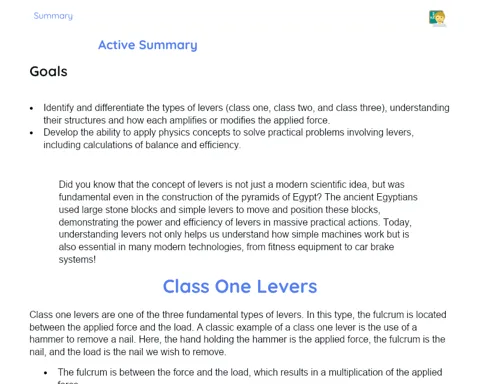Hydrostatics: Specific Mass | Active Summary
Objectives
1. 🎯 Clearly understand the concept of specific gravity, knowing that it is calculated by the relationship between the mass of an object and its volume.
2. 🎯 Differentiate specific gravity from relative density, understanding their definitions and how these concepts are applied in the real world.
Contextualization
Have you ever stopped to think about why some things float while others sink? 🚤⚓ This is directly related to the specific gravity of materials! For example, large steel ships float in the ocean while a small stone sinks quickly. This happens because the ships, although made of a dense material, are designed in such a way that the volume of water displaced is sufficient to keep them floating, perfectly illustrating the practical application of specific gravity. Fascinating, isn't it? 🌊🚢
Important Topics
Calculation of Specific Gravity
Specific gravity is a physical property defined as the mass per unit volume of a material. This concept is fundamental to understanding why objects of the same size can have very different weights due to variations in the specific gravity of the materials from which they are made. For example, iron and polystyrene can have the same volume, but iron has a much greater specific gravity.
-
Formula for calculating specific gravity: ρ = m / V, where ρ is the specific gravity, m is the mass, and V is the volume.
-
Understanding specific gravity is crucial for applications such as boat or balloon design, where the balance between mass and volume determines whether the object will float or sink.
-
Specific gravity is an intensive property, meaning it does not depend on the amount of material present, being an intrinsic characteristic of the material.
Difference Between Specific Gravity and Relative Density
While specific gravity is an absolute measure, relative density is a comparative measure that expresses the ratio between the specific gravity of a material and the specific gravity of a reference substance (typically water for liquids and solids). Thus, relative density is a way to understand how a material compares in terms of 'weight' to a standard material.
-
Relative density (RD) is calculated as RD = ρ_material / ρ_reference, where ρ_material is the specific gravity of the material and ρ_reference is the specific gravity of the reference material (usually water).
-
Relative density is dimensionless, meaning it has no unit, making comparisons between different materials easier.
-
Knowing the relative density helps in selecting materials for specific applications, such as manufacturing objects that should float or sink in a fluid.
Practical Applications of Specific Gravity
Knowledge of specific gravity is applied in numerous everyday situations and in industrial contexts. For example, engineers use this concept to choose appropriate materials for the construction of floating structures or to determine the load a vehicle can carry without risk of sinking.
-
In shipbuilding, the specific gravity of the materials used must be considered to ensure that the ship can float.
-
In ballistics, the specific gravity of projectiles influences both the trajectory and penetration of the object.
-
In the food industry, specific gravity is used to determine the quality and consistency of products, such as ice creams and mousses.
Key Terms
-
Specific Gravity: The ratio of the mass of an object to its volume, usually expressed in kg/m³.
-
Relative Density: The ratio between the specific gravity of a material and the specific gravity of a reference material, such as water, being a dimensionless measure.
-
Volume: The amount of three-dimensional space occupied by an object, measured in cubic units, such as cubic meters.
To Reflect
-
How can understanding specific gravity influence the design of everyday products like household items and packaging?
-
In what ways can relative density affect material choices in engineering projects, such as bridges or buildings?
-
How does the specific gravity of different gases impact the behavior of weather balloons or airships?
Important Conclusions
-
🌟 We recall that specific gravity is a fundamental property of materials, defined as mass per unit volume. This helps us understand why some objects float while others sink.
-
🌟 We discussed how to differentiate specific gravity from relative density, the latter being a comparison of a material's specific gravity to that of a standard, typically water.
-
🌟 We saw incredible practical applications of specific gravity, from designing boats that don't sink to the use in flying balloons, showing how physics is present in our daily lives.
To Exercise Knowledge
- Calculation at Home: Measure and calculate the specific gravity of three different objects at home. Use a scale to measure the mass and a ruler to calculate the volume. 📏📝
- Creative Research: Look for an object that floats in water and one that sinks. Try to predict the outcome before testing it and explain why this happens based on specific gravity. 🚤🥌
- Reflection Diary: Keep a small diary for a week, recording where you find applications of specific gravity in your daily life. This can include everything from cooking to sports. 📔✍️
Challenge
🚀 PET Bottle Submarine Challenge: Using a PET bottle, pieces of lead (or small stones), and a balloon, create a 'submarine' that can float and sink by controlling buoyancy. Adjust the amount of air in the balloon to control whether the submarine sinks or floats. Share a video of your submarine in action!
Study Tips
-
📚 Visualize with Videos: Watch videos about buoyancy and specific gravity to see the theory in action. Platforms like YouTube have practical demonstrations that can aid understanding.
-
📖 Read More: Look for books or articles that discuss the application of specific gravity in engineering and environmental sciences to see how this concept is used professionally.
-
🤔 Make Connections: Try to relate the concept of specific gravity to other areas of study, such as chemistry and biology, to understand how physics concepts are interconnected with other sciences.



